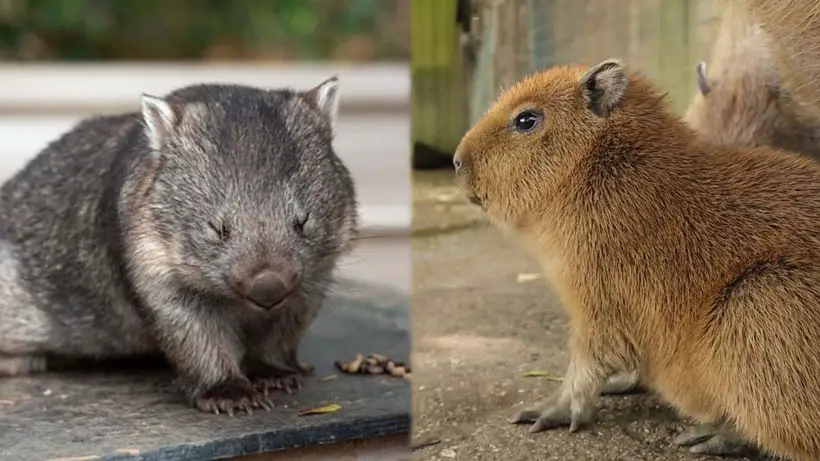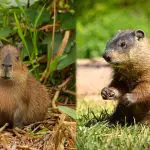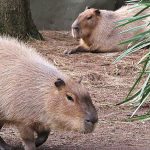Wombat vs. Capybara: Exploring the Differences Between Two Unique Mammals
Wombats and capybaras are unique mammals often compared due to their similar appearance. Both of these animals are interesting and unique in their own way, and understanding their differences is essential.
What are the differences between wombat vs. capybara? Wombats are burrowing herbivorous marsupials living in Australia, while capybaras are the largest rodents in the world and inhabit South America. Wombats also have strong legs and thick, sturdy bodies, while capybaras have webbed feet and sleek bodies.
Continue reading to discover wombats’ and capybaras’ physical characteristics, behavioral differences, and habitat preferences.
Overview of The Scientific Classification Between Wombat vs. Capybara

Here is a table showing the scientific classification of the wombat and the capybara.
| Common Name | Scientific Name | Order | Family | Genus | Species | |
| Wombat | Common wombat | Vombatus ursinus | Diprotodontia | Vombatidae | Vombatus | Ursinus |
| Southern hairy-nosed wombat | Lasiorhinus latifrons | Diprotodontia | Vombatidae | Lasiorhinus | Latifrons | |
| Northern hairy-nosed wombat | Lasiorhinus krefftii | Diprotodontia | Vombatidae | Lasiorhinus | Krefftii | |
| Capybara | Water Hog | Hydrochoerus hydrochaeris | Rodentia | Caviidae | Hydrochoerus | Hydrochaeris |
Overview of Key Differences Between Wombat vs. Capybara
These mammals have different physical and behavioral differences. Here is a table summarizing the key differences between Wombat and Capybara.
| Characteristic | Wombat | Capybara |
|---|---|---|
| Size | The average length of 3 feet, with a weight of 80 pounds | Can grow up to 4 feet long, weigh as much as 140 pounds |
| Fur Color | Short, dense fur ranging from sandy brown to dark brown or black | Long, shaggy fur typically tan in color |
| Feet | Flattened, hoof-like feet with sharp claws | Webbed feet for swimming, with sharp claws |
| Snout | Short, flattened snout | Long, narrow snout |
| Genus | Marsupial (genus Vombatus with 3 species) | Rodent (genus Hydrochoerus with 1 species) |
| Digging and Swimming Abilities | Skilled burrowers, but not great swimmers. | Semi-aquatic and excellent swimmers but aren’t skilled burrowers. |
| Offspring | Breed throughout the year and give birth to a single joey. | Mate for life and give birth to an average of four young pups. |
| Burrowing Habits | Create extensive underground burrows | Create shallow burrows near the water’s edge |
| Diet | Herbivores mainly feed on grass, bark, and roots. | Herbivores, opportunistic grazers that feed on various kinds of grass, aquatic plants, and occasionally, fruits and tree bark. |
| Social Behaviors and Communication | Primarily solitary animals that come together during mating season. | Highly social, live in groups of up to 20 individuals. |
| Communicate with vocalizations and scent markings. | Use vocalizations to communicate | |
| Activity Preference | Nocturnal and crepuscular | Diurnal |
| Habitat Preference | Native to Australia | Native to South America, |
| Matting and Reproduction | Polygamous with females giving birth to one young. | Polygamous with females give birth to up to eight young |
| Lifespan | 15 years | 8 to 10 years |
1. Wombat vs. Capybara: Physical Differences
Wombat and Capybara have several physical differences that set them apart. They include the following.

Size
Wombats are generally smaller than capybaras, with an average length of 3 feet and weight of 80 pounds. In contrast, capybaras can grow up to 4 feet long and weigh as much as 140 pounds.
This difference in size is reflected in their overall body shape, with wombats having a stocky and muscular build, while capybaras have a more elongated and slender body.

Fur Color
The fur color of wombats and capybaras also differs significantly. Wombats have short, dense fur ranging from sandy brown to dark brown or black. This fur protects them from the harsh Australian climate, which can be extremely hot and dry.
On the other hand, capybaras have long, shaggy fur that is typically tan. This fur helps to insulate them from the cool and damp conditions in their natural habitats.
Feet
Wombats have strong, stocky legs with flattened, hoof-like feet. Their feet have tough pads and sharp claws that allow them to dig through hard soil and rocky terrain. These claws also provide a secure grip when climbing steep slopes and logs.
In contrast, capybaras have webbed feet adapted for life in and around water. The webbing between their toes helps them swim faster and easily navigate marshy areas. Their feet are also equipped with sharp claws to defend against predators and climb out of the water onto the shore.
Snouts
One of the most noticeable physical differences between the wombat and capybara is their snouts. Wombats have short, flattened snouts that are perfectly adapted for digging burrows and roots. On the other hand, capybaras have long, narrow snouts perfectly adapted for grazing on grasses.
Digging and Swimming Abilities
Wombats are skilled burrowers, using their powerful legs and claws to dig complex underground tunnels and chambers. Wombat burrows can be up to 100 feet long and contain multiple entrances, chambers, and tunnels. Their burrows provide a safe refuge from predators, harsh weather conditions, and a place to sleep and raise young.
In contrast, capybaras are semi-aquatic and spend significant time in the water. They are excellent swimmers who can hold their breath for up to five minutes underwater.
Capybaras use their webbed feet to paddle through the water, and their eyes and nostrils are located on top of their heads, allowing them to see and breathe while swimming.
While wombats are not known for their swimming abilities, they can cross shallow streams and rivers to access food and other resources.
2. Behavioral Differences
In addition to their physical characteristics, wombats and capybaras have notable behavioral differences. Understanding these behavioral differences is crucial for effective control and wildlife management. They include the following.

Diet
Wombats are herbivores and mainly feed on grass, bark, and roots. Their strong jaws and teeth allow them to chew tough vegetation and store food in their cheeks to eat later.
In contrast, capybaras are classified as herbivores but are more accurately described as opportunistic grazers. They feed on various kinds of grass, aquatic plants, and occasionally, fruits and tree bark.
Capybaras have a unique digestive system that allows them to extract more nutrients from their food than other herbivores.
Social Behavior and Communication
Wombats are primarily solitary animals only known to come together during mating season. They communicate with each other using vocalizations and scent markings. They may also growl, hiss, or bite as a defense mechanism when threatened.

Conversely, capybaras are highly social animals that live in groups of up to 20 individuals. They use a variety of vocalizations, including grunts, barks, and whistles, to communicate with each other. They also engage in grooming behaviors to strengthen social bonds within the group.
Activity Preference
Wombats are primarily nocturnal animals and spend most of the day sleeping in their burrows. They come out at night to forage for food, and their powerful legs allow them to move quickly if they feel threatened.
On the other hand, capybaras are diurnal and are most active during the day. They spend much of their time grazing and resting near bodies of water to regulate their body temperature.
Habitat Preference and Range
Wombats are found mainly in Australia, where they inhabit forested areas and grasslands. They prefer habitats with varied vegetation types and a reliable water source.
Wombats are well adapted to living in areas with extreme temperature fluctuations, as their burrows maintain a relatively constant temperature year-round.
Capybaras are native to South America and found near rivers, lakes, and other bodies of water. They prefer abundant vegetation and water habitats, which are critical to survival. Capybaras are also adaptable to various environments, from tropical rainforests to grasslands and savannas.
Here is a video to help you understand these differences.
3. Wombat vs. Capybara: Mating, Reproduction, and Lifespan
Both the wombat and the capybara have different lifespans, mating rituals, and seasons. Here is an in-depth dive into these differences.
Mating Ritual and Habits
During the mating season, male wombats engage in a complex mating ritual, which involves a lot of chasing and circling of the female.
Male wombats also engage in a behavior known as “scent marking,” where they spray their urine on trees or rocks to leave their scent and attract potential mates.

Female wombats are receptive to mating for only a short period, and they will often mate with multiple males during this period to increase their chances of successful reproduction.
Capybaras also have a unique mating ritual that involves vocalizations, scent marking, and physical displays. During the mating season, male capybaras engage in vocalizations to attract females, and they use scent marking to establish dominance and attract potential mates.
When a male capybara pursues a female, she enters the water and swims back and forth.
The pair mates in the water, with the female often submerged for brief copulation. However, females not wanting to mate may dive deep enough to dislodge the male. The mating pair is often interrupted by a second male.
Mating Season
The breeding season for the common wombat usually occurs in the late months of the year, from September to December.
The mating season for capybaras usually occurs during the rainy season, which varies depending on the region, but generally falls between December and February in South America.
Reproduction, Life Cycle, and Lifespan
Wombats are marsupials, and females have a pouch in which they carry and nurse their young. After a gestation period of approximately 20 to 30 days, the young wombat, known as a joey, is born and crawls into the mother’s pouch.
The joey will remain in the pouch for about 6 to 8 months before emerging and staying close to its mother for another few months. Wombats have a lifespan of around 15 years in the wild.

Capybaras are rodents and give birth to fully developed young after a gestation period of around 130 to 150 days. The young capybara, known as a pup, is born on land and can walk and swim within a few hours.
The mother will nurse the pup for several months and stay with the mother for about a year before becoming independent. Capybaras have a lifespan of around 8 to 10 years in the wild.
If you’re curious about capybara behavior and their habitat, you might find our articles on why capybaras hang out with other animals and where capybaras live informative. Our article on why capybaras hang out with other animals explores the social nature of these fascinating creatures and sheds light on their cooperative relationships with other species. Additionally, our article on where capybaras live provides insights into their natural habitat, including the regions and environments they inhabit.FAQs
Here are a few additional questions about wombats and capybaras people ask frequently.
Q1: Are wombats and capybaras dangerous to humans?
A: Generally, wombats and capybaras are not dangerous to humans. They both are herbivorous and are not known to attack humans unprovoked. However, like wild animals, they can become aggressive if threatened or cornered.
Q2: Do wombats and capybaras make good pets?
No, wombats and capybaras are not suitable as pets. They are wild animals that require specialized care and habitats. In many countries, keeping them as pets is illegal and can be dangerous for the animal and the owner.
Q3: Can wombats and capybaras coexist in the same habitat?
No, wombats and capybaras do not typically coexist in the same habitat. They have different habitat preferences and ranges, with wombats primarily found in Australia and capybaras in South America.
Conclusion
Understanding the differences between the wombat and capybara is crucial for effective wildlife management and conservation efforts. These two unique mammals have distinct physical characteristics, behavioral differences, and habitat preferences. They impact their interactions with their environment and other species.
Further research on these fascinating creatures is necessary to protect them and their habitats for future generations to appreciate and enjoy.




